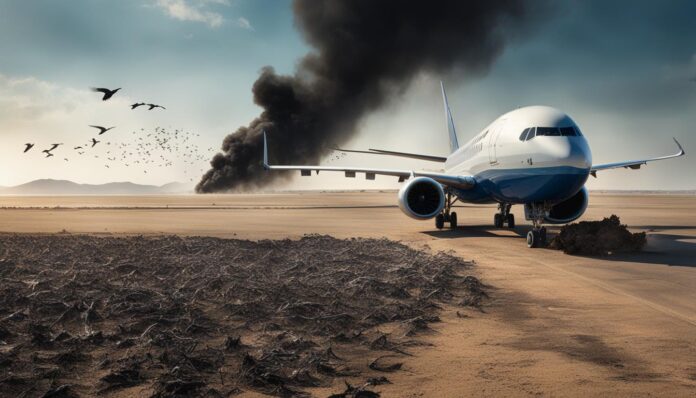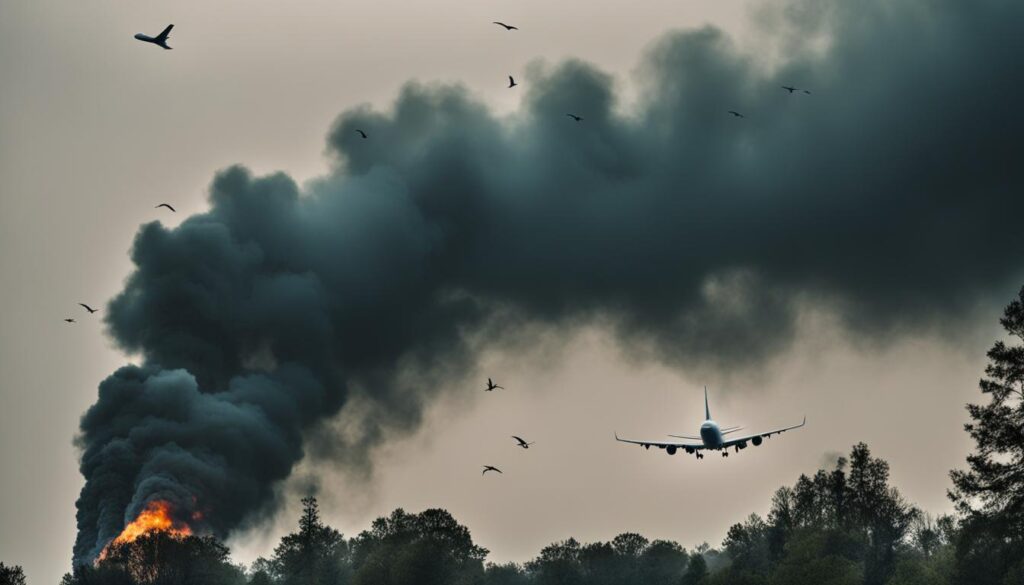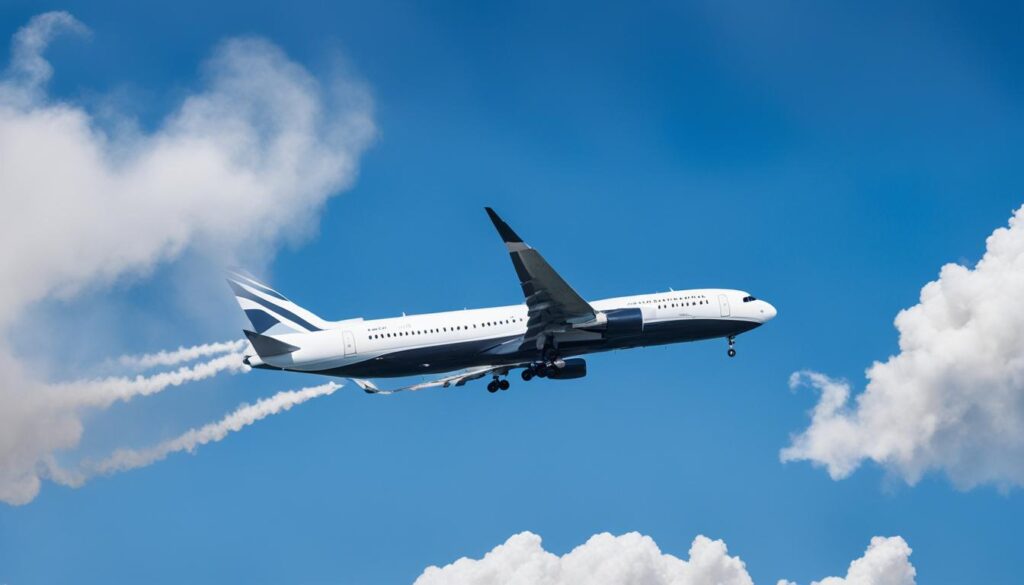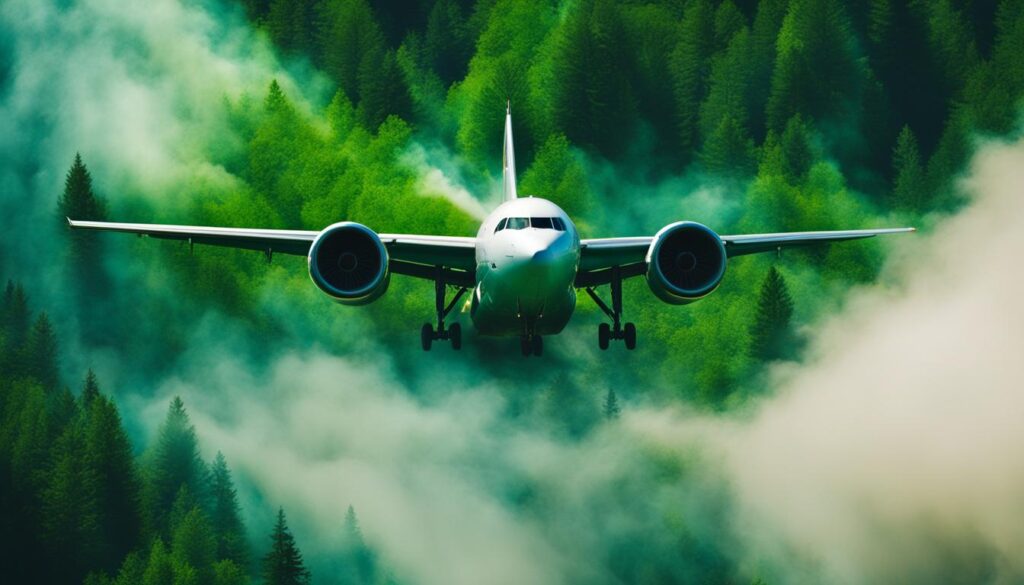If you are wondering what the environmental impacts of air travel are, you have come to the right place. With the rise in air travel, there is a growing concern about its effects on the environment. Air travel contributes significantly to environmental problems, and these impacts are only expected to increase with the rise in global travel. In this section, we will provide an overview of the environmental impacts of air travel.
As you read, keep in mind that sustainable air travel practices and alternatives are essential to reducing the negative environmental effects of air travel. Let’s dive in to understand the environmental impacts of air travel and what you can do to minimize your carbon footprint.
Carbon Emissions from Air Travel
Did you know that air travel is a significant source of carbon emissions? According to the International Air Transport Association (IATA), aviation contributes around 2% of global carbon emissions. While it may not seem like much, the impact is significant, considering that air travel continues to grow.
The carbon emissions from air travel are primarily caused by burning jet fuel, which releases carbon dioxide (CO2) and other gases into the atmosphere. These emissions trap heat in the Earth’s atmosphere, leading to global warming and climate change.
In addition to the direct emissions from burning jet fuel, air travel also contributes to indirect emissions. For example, airplanes release nitrogen oxides (NOx), which contribute to the formation of ozone in the atmosphere. While ozone occurs naturally in the upper atmosphere and provides a protective layer, at lower altitudes, it can have harmful effects on human health and the environment.
Reducing carbon emissions from air travel is challenging as the industry continues to grow. However, there are steps that airlines and individuals can take to reduce their carbon footprint, such as investing in new aircraft technology, improving air traffic management systems, using biofuels, and reducing unnecessary air travel.
Air Travel Pollution
Air travel is a significant contributor to pollution, mainly through emissions released by aircraft engines. The two forms of air travel pollution are:
- Gas pollutants – sulfur dioxide, nitrogen oxides, and carbon monoxide which contribute to the formation of ozone and photochemical smog.
- Particulate matter – tiny particles suspended in the air which can harm human health and contribute to climate change.
In addition, noise pollution is another vital aspect of air travel pollution. The excessive and repetitive noise generated by airplanes affects the local communities near airports.
Gasoline consumption and pollution
Flying uses large quantities of gasoline and emits significant quantities of greenhouse gases. One kilometer flown by a passenger results in roughly the same amount of greenhouse gas emissions as one kilometer driven by a car.
“Airlines are responsible for around 2% of global greenhouse gas emissions.”
According to aviation experts, implementing new technologies that reduce fuel consumption and greenhouse gas emissions, together with more efficient flight routes, could help mitigate air travel pollution significantly.
Climate Change and Air Travel
You may wonder how air travel contributes to climate change. However, studies have shown that countries’ aviation industries generate approximately 2-3% of all carbon emissions annually. This may seem like a tiny percentage, but when compared to other industries, such as transportation and energy production, it can have significant effects on the environment.
Carbon emissions are not the only way that air travel affects the climate. According to the Intergovernmental Panel on Climate Change (IPCC), aviation is responsible for other emissions that contribute to climate change, such as nitrogen oxides, water vapor, and aerosols.
Furthermore, the altitude at which airplanes operate has a more significant impact on climate change than emissions alone. When airplanes fly above 26,000 feet, their exhaust leads to the formation of contrails, which trap heat in the atmosphere and contribute to the greenhouse effect.
The Role of Aviation in Global Warming
The rise in global temperature is a direct consequence of the greenhouse effect and global warming, in which human activities play a significant role. Greenhouse gases, including carbon dioxide (CO2), methane (CH4), and water vapor, trap heat in the atmosphere, resulting in a rise in temperature. One of the most substantial contributors to this effect is the aviation industry, which is rapidly expanding.
Moreover, global warming caused by air travel may have disastrous consequences for the environment, including melting glaciers, rising sea levels, and an increase in climate events like hurricanes and heat waves.
“Aviation is responsible for a significant amount of emissions that contribute to climate change and its associated effects. It is crucial to promote green travel alternatives and reduce the impact of air travel on the environment.”
Greenhouse Gas Emissions from Air Travel
Air travel is one of the main contributors to greenhouse gas emissions, producing high amounts of carbon dioxide and other gases that trap heat in the atmosphere. These emissions are the result of burning large amounts of jet fuel to propel aircraft and power their various systems. Carbon dioxide is the most significant greenhouse gas emitted by air travel, accounting for about 90% of emissions from the aviation industry. Other gases such as nitrous oxide and water vapor also contribute to the warming effect of these emissions, although their impact is relatively small.
According to the International Air Transport Association (IATA), the aviation industry produced approximately 915 million tons of carbon dioxide in 2019, accounting for about 2.4% of global carbon dioxide emissions. However, some estimates suggest that when non-CO2 effects are factored in, such as contrail and cirrus cloud formation, the total warming effect of aviation emissions is closer to 5% of the global total.
It’s worth noting that the COVID-19 pandemic had a significant impact on air travel, resulting in a drop in greenhouse gas emissions from the aviation industry. However, as travel resumes, these emissions are likely to rebound, and the industry will once again become a significant contributor to global emissions.
Green Initiatives in the Aviation Industry
Many airlines and aviation companies have implemented various measures to reduce the greenhouse gas emissions associated with air travel. Some of these include investing in more fuel-efficient aircraft, developing alternative fuels such as biofuels, and implementing operational changes to optimize flight routes and reduce taxiing time on the ground. In addition, some airlines offer carbon offset programs, where customers can pay an additional fee to offset the emissions generated by their flights.
However, these measures alone may not be sufficient to offset the impact of increasing air travel demand. Structural changes to the industry, such as a shift towards more sustainable modes of transportation or the implementation of regulatory frameworks to reduce emissions, may be necessary to effectively address the environmental impact of air travel.
Aviation and its Environmental Effects
While carbon emissions are the most well-known and widely-discussed environmental impact from aviation, there are additional effects that must be considered. One of these is deforestation.
The construction and maintenance of airports often require large amounts of land, which can result in the removal of forests and other natural habitats. This can have significant impacts on biodiversity and the health of local ecosystems.
Additionally, noise pollution from aviation can disrupt animal behavior and communication, leading to disturbances in wildlife populations.
Furthermore, the large quantities of waste produced by airports and airplanes can have negative consequences on local water sources and soil quality.
As the demand for air travel continues to rise, it’s important to recognize the broader environmental effects of aviation and work towards mitigating them through sustainable practices and alternative modes of transport.
Aviation and Deforestation
Deforestation resulting from aviation can be both direct and indirect. Direct deforestation occurs when airports and other aviation infrastructure are constructed on land that was previously forested. Indirect deforestation can occur when the production and transportation of aviation fuel leads to the removal of forests for agricultural purposes or for mining oil and gas.
A report by the United Nations’ Food and Agriculture Organization estimates that deforestation is responsible for 12-20% of global greenhouse gas emissions, making it one of the largest contributors to climate change. Additionally, deforestation can lead to soil erosion, loss of biodiversity, and disruption of local water cycles.
Reducing deforestation caused by aviation requires a comprehensive approach. This includes measures such as promoting sustainable biofuels, investing in renewable energy sources for airport operations, and implementing carbon offset programs to fund reforestation efforts.
Aviation and Noise Pollution
The noise produced by airplanes taking off and landing can be incredibly disruptive to wildlife populations. Animals may experience changes in behavior such as altered feeding patterns, decreased mating activity, and disruptions to migration paths.
A study conducted by the Australian government found that noise from aviation negatively impacted the nesting and feeding behaviors of several bird species. Similarly, research conducted by the National Park Service found that aviation induced noise had negative consequences for elk, bison, and other wildlife in Yellowstone National Park.
To mitigate the impact of aviation-induced noise pollution, airports can implement noise abatement procedures, such as altering flight patterns or using noise-reducing materials on runways and aircraft. Additionally, airports may choose to conduct thorough environmental impact assessments prior to construction and expansion.
Carbon Footprint of Flying
When you think of the carbon footprint of flying, the first thing that comes to mind is probably the carbon dioxide emissions from the plane. While CO2 is the primary greenhouse gas produced by airplanes, it is not the only factor that contributes to the carbon footprint of flying. Other factors that influence the carbon footprint of flying include:
| Factors | Impact |
|---|---|
| Number of passengers on the plane | More passengers mean a higher carbon footprint per person |
| Distance traveled | The longer the flight, the higher the carbon footprint |
| Aircraft type | Older planes tend to have higher emissions than newer ones |
| Fuel efficiency | More fuel-efficient planes have a lower carbon footprint |
It’s important to note that the carbon footprint of flying is significant. According to the International Civil Aviation Organization, aviation is responsible for around 2% of global carbon dioxide emissions. Additionally, flying is often the most carbon-intensive form of transportation per unit of distance traveled.
To reduce your carbon footprint when flying, consider offsetting your emissions by supporting carbon reduction projects or choosing alternative modes of transportation when possible.
Air Travel and Global Warming
Air travel has a significant impact on global warming, contributing to around 2.5% of global CO2 emissions. This may not seem like a large percentage, but air travel’s carbon footprint is growing, with the demand for air travel projected to possibly triple in the next 30 years.
Global warming and climate change caused by CO2 emissions can have devastating long-term effects on the planet, such as rising sea levels, increased frequency and severity of natural disasters, and negative impacts on biodiversity and ecosystems.
Reducing air travel is one way to help mitigate its impact on global warming. When possible, consider other modes of transportation, such as trains or buses, or opt for virtual meetings instead of in-person travel. For essential air travel, airlines are working to reduce their carbon emissions through technology advancements and sustainable aviation fuel.
“Sustainable aviation fuel has the potential to reduce the industry’s carbon footprint by up to 80%, providing a significant contribution to the environment.”
Key Takeaways
- Air travel contributes to approximately 2.5% of global CO2 emissions
- The carbon footprint of air travel is expected to increase with growing demand
- Global warming caused by CO2 emissions can have severe long-term effects on the planet
- Reducing air travel and using sustainable aviation fuel are ways to mitigate the impact on global warming
Environmental Implications of Flying
While air travel has revolutionized the way we explore the world, it has significant implications for the environment, including biodiversity loss and ecosystem disruption. The environmental effects of flying extend beyond the carbon emissions produced by planes, affecting the delicate balance of ecosystems on land and in the sea.
One of the most significant impacts of flying on the environment is habitat destruction caused by the expansion of airports and the construction of new aviation infrastructure. The disruption of natural habitats can lead to a loss of biodiversity, affecting the survival of countless species that rely on these environments for food, shelter, and breeding grounds.
In addition to habitat destruction, flying also contributes to noise pollution, which can have a range of environmental impacts. High levels of noise pollution from airports and planes have been associated with stress and damage to the hearing of wildlife and domestic animals.
Furthermore, airports and airplanes generate significant amounts of waste, including food waste, plastic waste, and hazardous waste. Proper waste management is critical to prevent environmental pollution and reduce the environmental impact of flying.
To mitigate the environmental implications of flying, airlines and aviation companies have introduced several sustainability initiatives, including the use of biofuels, modernizing fleets with more fuel-efficient aircraft, and investing in carbon offsetting programs. However, more needs to be done to minimize the impact of flying on the environment and protect our planet for future generations.
Environmental Impacts of Flying Table
| Environmental Impact | Description |
|---|---|
| Habitat Destruction | Expansion of airports and aviation infrastructure leads to the destruction of natural habitats and loss of biodiversity. |
| Noise Pollution | High levels of noise pollution from airports and planes can cause stress and impact the hearing of wildlife and animals. |
| Waste Generation | Airports and airplanes generate significant amounts of waste, including food waste, plastic waste, and hazardous waste, which can pollute the environment. |
| Carbon Emissions | Planes emit greenhouse gases that contribute to global warming and climate change, affecting ecosystems and wildlife. |
Other Environmental Considerations
In addition to carbon emissions, air travel has several other environmental impacts that are important to consider. One of these impacts is water pollution. Aircraft can release pollutants into bodies of water during takeoff and landing. These pollutants can harm aquatic ecosystems, making it difficult for fish and other organisms to survive.
Waste management is another environmental consideration associated with air travel. Each year, airlines produce tons of waste, including food waste, plastic cups, and paper products. If not disposed of properly, this waste can contribute to land pollution and harm wildlife.
As you can see, the environmental impacts of air travel extend far beyond carbon emissions alone. It’s essential for the aviation industry to address these impacts and work towards more sustainable practices.
“We need to recognize that aviation is not just another economic activity. It is highly dependent on fossil fuels and emits greenhouse gases at high altitudes, where their impacts on climate are particularly potent.”
– Achim Steiner
Environmental Impact Comparison Table
| Environmental Impact | Carbon Emissions from Air Travel | Water Pollution from Air Travel | Waste Management in Air Travel |
|---|---|---|---|
| Details | Affects climate change, causes global warming | Affects aquatic life and ecosystems | Produces waste that can harm the environment |
| Solutions | Implement sustainable aviation practices, invest in biofuels | Reduce water pollution through stricter regulations and monitoring | Reduce waste through recycling and composting |
Conclusion
Now that you have a better understanding of the environmental impacts of air travel, it’s clear that flying has significant consequences for the planet. The carbon emissions, air and noise pollution, and other environmental effects caused by air travel are contributing to climate change and the degradation of ecosystems across the globe.
It’s important to recognize that the choices we make as individuals can have a significant impact on reducing the environmental footprint of air travel. By opting for sustainable practices such as carbon offsetting, reducing air travel, or choosing green airlines, we can help minimize the environmental impacts of air travel.
Furthermore, governments and the aviation industry must work together to prioritize sustainable practices and alternative technologies. This may include increasing investment in clean energy and other innovative technologies that can reduce the environmental impacts of air travel.
In conclusion, the environmental impacts of air travel are undeniable, and it’s up to all of us to take action to minimize these effects. With the right collective effort, we can help ensure that air travel remains a viable mode of transportation while protecting the planet for future generations.
















































